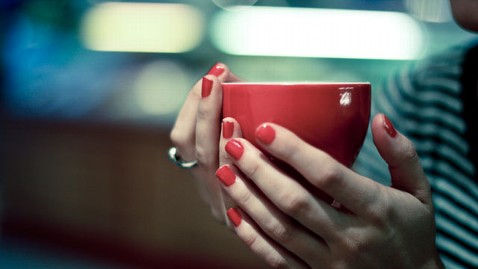The Physics of Carrying a Coffee Cup Without Spilling

A coffee mug, pre-spill. Image credit: Andy Teo/Getty Images
Rouslan Krechetnikov is a mechanical engineer at the University of California at Santa Barbara, and he spends most of his time working on fluid dynamics - the flow of air on a plane's wings, the stability of a rocket, and other weighty problems.
None of that has brought him as much attention as his newest paper in the journal Physical Review E: " Walking with coffee: Why does it spill?"
Krechetnikov and a graduate student, Hans Mayer, decided to divert from weightier subjects last year after a scientific conference, where they had watched fellow researchers stumble to their tables, trying not to get coffee all over themselves and the floor. Many of them failed, of course; coffee in the average cup sloshes back and forth with a frequency very close to that of the average coffee drinker's gait.
"The project was certainly fun. We just wanted to satisfy our curiosity and, given the results, to share what we learned with the scientific community through peer-reviewed literature," Krechetnikov wrote in an email to ABC News.
They could, of course, have gone back to work on flow topology and thin-film behavior - but far more fingers have been burned and clothes stained by spilled coffee. So they set up a simple experiment, watching a person walk in a straight line, mug in hand.
They had their test subject look at the coffee cup. They had their test subject look at the floor ahead. They shot video of it all, recording how the coffee oscillated and how long it took to spill.
The physics of a fluid in a cup, and the rhythm of human footsteps, could fill a paper in Physical Review E. (And, as Krechetnikov points out, if you can understand sloshing coffee, you can also calculate how sloshing fuel may destabilize a rocket.) But the engineers did come away with a few basic take-home (or take-to-the-coffee-machine) points:
- Don't rush. You may think the coffee will spill less if you get it to the table more quickly, but the opposite is true. Slow down and the sloshing will too.
- Watch the cup, not the floor. You'll spill less.
Sound like obvious advice? It does take a sense of humor to publish a scientific paper whose abstract concludes: "The studied problem represents an example of the interplay between the complex motion of a cup, due to the biomechanics of a walking individual, and the low-viscosity-liquid dynamics in it."
Krechetnikov admitted he was surprised by the attention the paper drew. "But, of course," he said, "there are many people who are curious not only about black holes but also about everyday ordinary phenomena."
Jon Cartwright of ScienceNow (published by the journal Science) had a little fun and ran the paper by Andrzej Herczynski, a physicist at Boston College. His response:
"I was personally a bit disappointed that the study is limited to cylindrical mugs … leaving out the very common curved or conical cups, such as those used for cappuccinos and lattes in Italy. Still, the paper seems at minimum destined for the Ig Nobel Prize."
Perhaps. But in his email to us, Krechetnikov quoted the famed 20th-century scientist Linus Pauling: "Satisfaction of one's curiosity is one of the greatest sources of happiness in life."